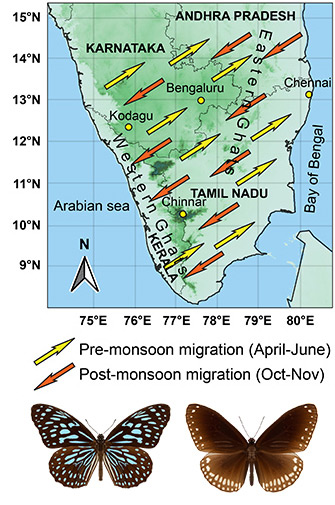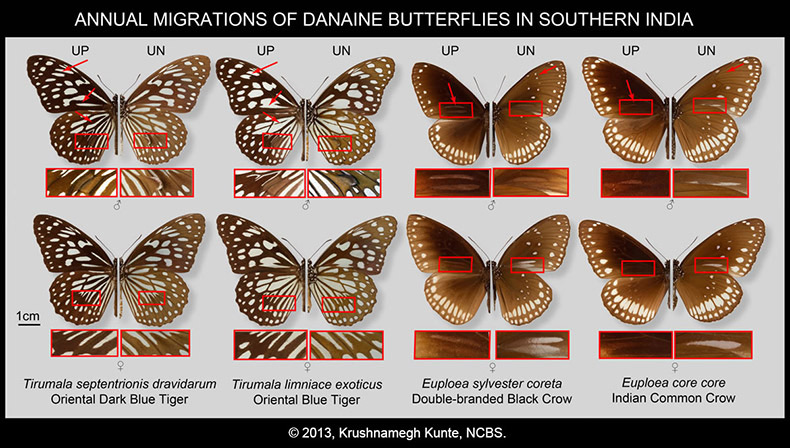Many animals frequently respond to unfavorable environmental changes in their current habitat by migrating to other areas. Seasonally predictable, annually recurring unfavorable changes in habitat conditions have led to such spectacular annual events in certain areas as the large mammalian migrations across the African plains, and the monarch butterfly migrations across North America. India has its share of large-scale migrations: millions of waterfowl migrate from Siberia to India and back around winter, and hundreds of species of forest birds and insects migrate from higher elevations to lower elevations or to the plains and back to the Himalaya in response to cold winters. Our lab strives to understand the population biology, genetics and behavioral mechanisms of such large scale annual migrations in India.
 One particular large-scale annual migration that is quite fascinating but has remained largely unexplored is the milkweed butterfly migration across southern India. Two species make up the overwhelming majority in these migrating swarms: Tirumala septentrionis dravidarum (Dakhan Dark Blue Tiger) and Euploea sylvester coreta (Double-branded Black Crow) (Lepidoptera: Nymphalidae: Danaini). Two other species also make a significant part of the swarms: Tirumala limniace exoticus (Oriental Blue Tiger) and Euploea core core (Indian Common Crow). Migration takes place across the plains of southern India to the southern part of the Sahyadri (also known as the Western Ghats) between mid-October and early December every year. Migrant butterflies initially remain in reproductive diapause for a few weeks after reaching the Sahyadri. They then breed in these mountains, and their progeny migrates to the eastern plains between April and July the following year. Thus, butterflies leave the southern Sahyadri just before the onset of the south-western monsoon, and return soon after the monsoon rains subside, escaping the nearly incessant rains and mist that cover the southern part of Sahyadri from June to September. The butterflies breed during the south-western monsoon on the eastern plains, in the rainshadow area, and their progeny then migrate back to the Sahyadri between October and early December. The migratory swarms typically consist of several million, perhaps tens of million, butterflies. A few other butterflies such as Danaus genutia (Striped Tiger) and Catopsilia pomona (Lemon Emigrant) may also join these migratory swarms, but their numbers are typically much smaller compared to the two main species.
One particular large-scale annual migration that is quite fascinating but has remained largely unexplored is the milkweed butterfly migration across southern India. Two species make up the overwhelming majority in these migrating swarms: Tirumala septentrionis dravidarum (Dakhan Dark Blue Tiger) and Euploea sylvester coreta (Double-branded Black Crow) (Lepidoptera: Nymphalidae: Danaini). Two other species also make a significant part of the swarms: Tirumala limniace exoticus (Oriental Blue Tiger) and Euploea core core (Indian Common Crow). Migration takes place across the plains of southern India to the southern part of the Sahyadri (also known as the Western Ghats) between mid-October and early December every year. Migrant butterflies initially remain in reproductive diapause for a few weeks after reaching the Sahyadri. They then breed in these mountains, and their progeny migrates to the eastern plains between April and July the following year. Thus, butterflies leave the southern Sahyadri just before the onset of the south-western monsoon, and return soon after the monsoon rains subside, escaping the nearly incessant rains and mist that cover the southern part of Sahyadri from June to September. The butterflies breed during the south-western monsoon on the eastern plains, in the rainshadow area, and their progeny then migrate back to the Sahyadri between October and early December. The migratory swarms typically consist of several million, perhaps tens of million, butterflies. A few other butterflies such as Danaus genutia (Striped Tiger) and Catopsilia pomona (Lemon Emigrant) may also join these migratory swarms, but their numbers are typically much smaller compared to the two main species.

The working model of the annual danaine migration in southern India.
Image by Vaishali Bhaumik, from Bhaumik and Kunte (2018), from information in Kunte (2005) and Bhaumik and Kunte (2018).
This annual migration is remarkable for two reasons. First, it seems to take place in response to the torrential monsoon rains in the Sahyadri. This is in contrast to most well-known migrations, which usually take place in response to cold or doughts. Second, this migration is longitudinal (east-west), not latitudinal (north-south) or altitudinal like most other well-known migrations. This is presumably because of the monsoonal patterns in peninsular India.
We are currently studying how the Indian monsoon influences population biology of T. s. dravidarum and E. s. coreta, and what the evolutionary and genetic consequences of migratory behavior are in these migratory populations. Please contact us if you wish to participate in this study or otherwise help in understanding this migration.
We receive a considerable number of requests to explain the distinctive characters of the various migratory danaines in southern India. We have, therefore, prepared the following figure that may assist you in determining the species identity and sex of the four main migratory species:

Identification and sexing of the four danaine species that participate in the annual longitudinal migrations in India.
Image by Payel Chatterjee, Gaurav Agavekar and Krushnamegh Kunte, NCBS.
In the figure above red arrows point to species differences whereas red boxes show sexual and/or species differences. Tirumala s. dravidarum differs from T. l. exoticus in having: (1) longer, narrower, and darker blue streaks beyond the forewing cell, (2) blue streaks and spots in forewing 1a and 1b being largely separated (prominently fused in T. l. exoticus), and (3) the hindwing cell having a 'V'-shaped blue mark, arms of which are widely separated (cell is blue with a narrow brown streak in T. l. exoticus). Tirumala males have a scent pouch on the hindwing, which is pendulous and protrudes on the underside of the hindwing but has its opening on the upperside. These pouches are absent in females.
Euploea s. coreta differs from E. c. core in having two small white spots beyond the cell on the forewing underside, which are missing in E. c. core (both (sub)species have a single, white costal spot). Euploea s. coreta males differ from E. c. core males in having two long and prominent sex brands on the forewing upperside, which appear as velvety streaks on the forewing underside. Euploea c. core males have a single, somewhat inconspicuous brand upper forewing, which appears as a dark patch over a white streak on forewing underside. Euploea s. coreta females have two pale streaks on forewing upperside and two prominent white streaks on forewing underside, whereas E. c. core females have a single white streak on forewing underside.
Publications:
Bhaumik, V., and K. Kunte. 2020. Dispersal and migration have contrasting effects on butterfly flight morphology and reproduction. Biology Letters, 16:20200393. PDF file (730 KB). See popular science coverage in NCBS News, EurekAlert!, Research Matters, and Le Monde (in French).
Bhaumik, V., and K. Kunte. 2018. Female butterflies modulate investment in reproduction and flight in response to monsoon-driven migrations. Oikos, 127:285–296. PDF file (4.3MB, has colour figures). See popular science coverage on EurekAlet!, NCBS News, and The Hindu.
Kunte, K. 2005. Species composition, sex-ratio and movement patterns in danaine butterfly migrations in southern India. Journal of Bombay Natural History Society, 102:280-286. PDF file (700KB).
